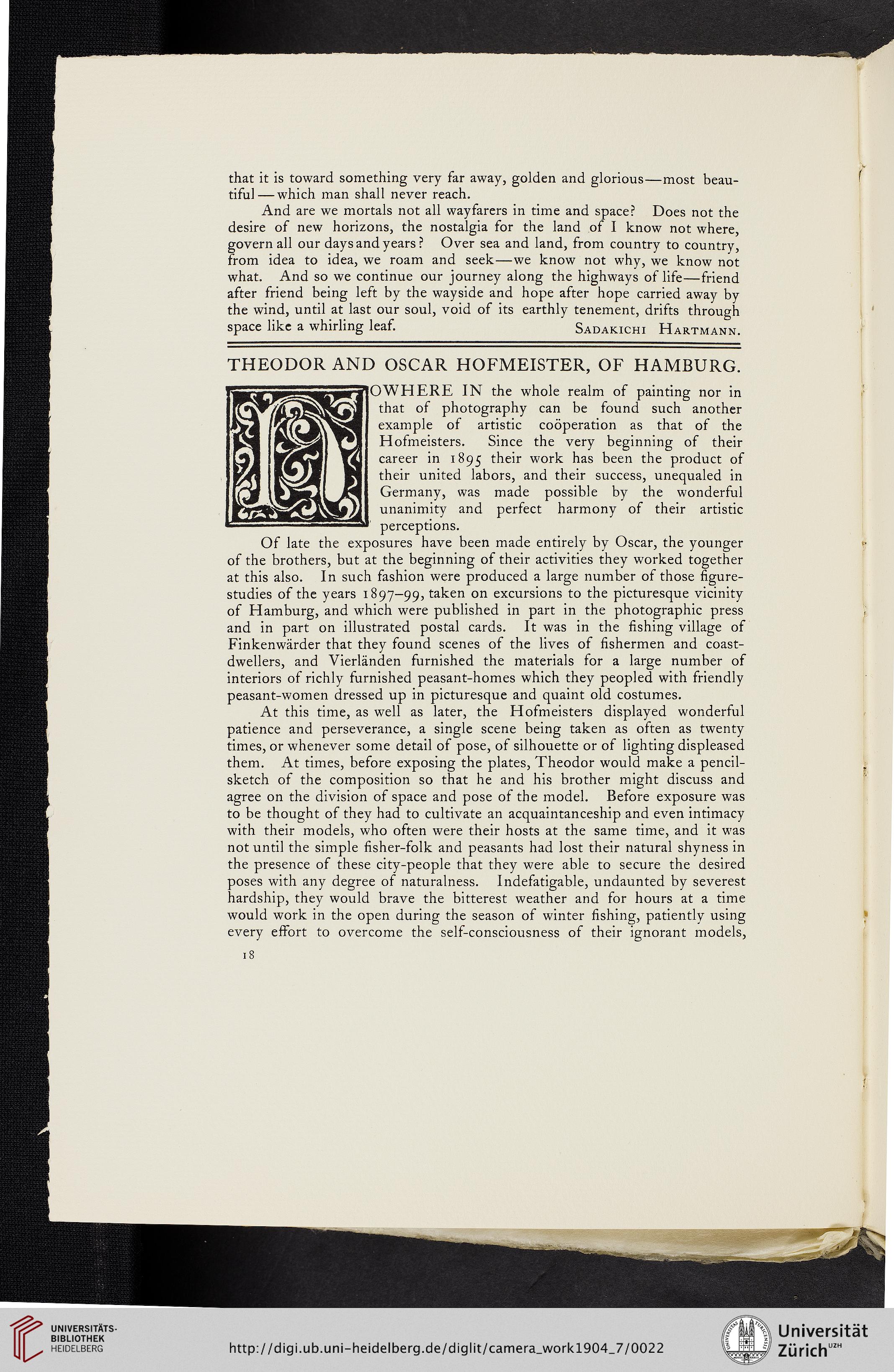Für diese Seite ist auch eine manuell angefertigte Transkription bzw. Edition verfügbar. Bitte wechseln Sie dafür zum Reiter "Transkription" oder "Edition".
that it is toward something very far away, golden and glorious—most beau-
tiful—which man shall never reach.
And are we mortals not all wayfarers in time and space? Does not the
desire of new horizons, the nostalgia for the land of I know not where,
govern all our days and years ? Over sea and land, from country to country,
from idea to idea, we roam and seek—we know not why, we know not
what. And so we continue our journey along the highways of life—friend
after friend being left by the wayside and hope after hope carried away by
the wind, until at last our soul, void of its earthly tenement, drifts through
space like a whirling leaf. Sadakichi Hartmann.
THEODOR AND OSCAR HOFMEISTER, OF HAMBURG.
NOWHERE IN the whole realm of painting nor in
that of photography can be found such another
example of artistic coöperation as that of the
Hofmeisters. Since the very beginning of their
career in 1895 their work has been the product of
their united labors, and their success, unequaled in
Germany, was made possible by the wonderful
unanimity and perfect harmony of their artistic
perceptions.
Of late the exposures have been made entirely by Oscar, the younger
of the brothers, but at the beginning of their activities they worked together
at this also. In such fashion were produced a large number of those figure-
studies of the years 1897-99, taken on excursions to the picturesque vicinity
of Hamburg, and which were published in part in the photographic press
and in part on illustrated postal cards. It was in the fishing village of
Finkenwärder that they found scenes of the lives of fishermen and coast-
dwellers, and Vierländen furnished the materials for a large number of
interiors of richly furnished peasant-homes which they peopled with friendly
peasant-women dressed up in picturesque and quaint old costumes.
At this time, as well as later, the Hofmeisters displayed wonderful
patience and perseverance, a single scene being taken as often as twenty
times, or whenever some detail of pose, of silhouette or of lighting displeased
them. At times, before exposing the plates, Theodor would make a pencil-
sketch of the composition so that he and his brother might discuss and
agree on the division of space and pose of the model. Before exposure was
to be thought of they had to cultivate an acquaintanceship and even intimacy
with their models, who often were their hosts at the same time, and it was
not until the simple fisher-folk and peasants had lost their natural shyness in
the presence of these city-people that they were able to secure the desired
poses with any degree of naturalness. Indefatigable, undaunted by severest
hardship, they would brave the bitterest weather and for hours at a time
would work in the open during the season of winter fishing, patiently using
every effort to overcome the self-consciousness of their ignorant models,
18
tiful—which man shall never reach.
And are we mortals not all wayfarers in time and space? Does not the
desire of new horizons, the nostalgia for the land of I know not where,
govern all our days and years ? Over sea and land, from country to country,
from idea to idea, we roam and seek—we know not why, we know not
what. And so we continue our journey along the highways of life—friend
after friend being left by the wayside and hope after hope carried away by
the wind, until at last our soul, void of its earthly tenement, drifts through
space like a whirling leaf. Sadakichi Hartmann.
THEODOR AND OSCAR HOFMEISTER, OF HAMBURG.
NOWHERE IN the whole realm of painting nor in
that of photography can be found such another
example of artistic coöperation as that of the
Hofmeisters. Since the very beginning of their
career in 1895 their work has been the product of
their united labors, and their success, unequaled in
Germany, was made possible by the wonderful
unanimity and perfect harmony of their artistic
perceptions.
Of late the exposures have been made entirely by Oscar, the younger
of the brothers, but at the beginning of their activities they worked together
at this also. In such fashion were produced a large number of those figure-
studies of the years 1897-99, taken on excursions to the picturesque vicinity
of Hamburg, and which were published in part in the photographic press
and in part on illustrated postal cards. It was in the fishing village of
Finkenwärder that they found scenes of the lives of fishermen and coast-
dwellers, and Vierländen furnished the materials for a large number of
interiors of richly furnished peasant-homes which they peopled with friendly
peasant-women dressed up in picturesque and quaint old costumes.
At this time, as well as later, the Hofmeisters displayed wonderful
patience and perseverance, a single scene being taken as often as twenty
times, or whenever some detail of pose, of silhouette or of lighting displeased
them. At times, before exposing the plates, Theodor would make a pencil-
sketch of the composition so that he and his brother might discuss and
agree on the division of space and pose of the model. Before exposure was
to be thought of they had to cultivate an acquaintanceship and even intimacy
with their models, who often were their hosts at the same time, and it was
not until the simple fisher-folk and peasants had lost their natural shyness in
the presence of these city-people that they were able to secure the desired
poses with any degree of naturalness. Indefatigable, undaunted by severest
hardship, they would brave the bitterest weather and for hours at a time
would work in the open during the season of winter fishing, patiently using
every effort to overcome the self-consciousness of their ignorant models,
18


